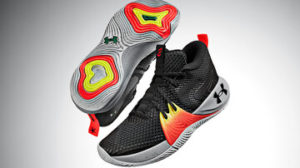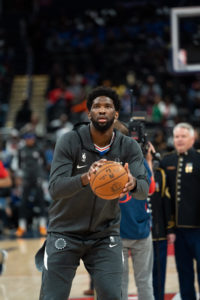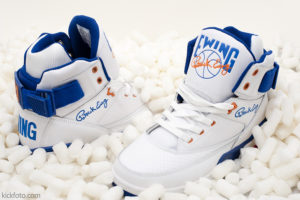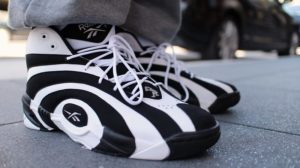The world just earned its first glimpse of the Embiid 1 Origin.

A sunburst red-and-orange wing creeps up the black mesh body, a ridged rainbow pattern carves through the sole, and a subtle Under Armour logo lingers on the back of the heel. This is the first signature shoe for the company’s newest signee, Philadelphia 76ers center Joel Embiid. As a client, Embiid makes all the sense in the world. He is a remarkable athlete, known for both beautiful footwork as well as some truly rim-rattling dunks throughout the course of his five-year career. He matches that swagger off the court with a natural quippiness, a persnickety temperament, and an accent that drips with honey. Catch him roasting rival center Andre Drummond on Twitter, or casually rebuffing Rihanna in a post-game interview. The combination of dominance and self-promotional savvy he embodies is crucial in the sneaker industry. Somebody was bound to snatch Embiid up. He checks all the boxes.
There’s only one problem.
Embiid stands at an even seven feet, and according to an adage that’s as old as the NBA itself, big men don’t move merchandise. The greatest sneaker barons in basketball — like Michael Jordan, Kobe Bryant, and Allen Iverson — were at their best off the block and outside of the paint. That makes Embiid an outlier. He’s an heir to dominant centers like Tim Duncan and Hakeem Olajuwon — both far better known for their title chases than they are for their fashion game. Embiid, like his predecessors, is well aware of that reputation. If the Embiid 1 Origins take over the world upon impact, he’ll reverse fifty years of history.
“A lot of people, you know, always have that notion [that] big men can’t sell shoes. And when I look at myself … I’m more than a big man,” Embiid told ESPN in 2018. “So as far as signature shoes, I’m excited to come and break that.”
In 1971, Adidas signed the eventual all-time NBA points leader Kareem Abdul-Jabbar to endorse the Superstar, the first ever signature shoe for a basketball player.

They’re still on shelves today, and they remain an all-time classic: crispy and clean, with three black stripes and an indelible silhouette. Kareem, of course, stood at a towering 7’2, and played with a preternatural command that nobody could replicate — not even if they bought his shoes. It didn’t matter. The Superstar reigned supreme. The greatest big man of all time opened the door for the basketball nobility in his wake.
So it’s ironic that, in 1984, as a phenom named Michael Jordan was making his first marks on the game, Adidas declined to extend him an offer. The reasoning? According to the Wall Street Journal, the executives felt they were better off restricting their roster to players like Abdul-Jabbar. Michael Jordan, in essence, was deemed too short.
You probably know what happens from there. Jordan inks a blockbuster deal with Nike which introduces his own Air Jordan brand, and, within a few years, he’s responsible for the single greatest footwear empire in fashion history. Adidas lost its dominant hold on the market practically overnight, and the company has yet to fully recover. It is difficult to chalk up a generational shift to one bad business deal, but since that fateful 1984 snubbing, big men have watched their presence in the sneaker industry slowly shrivel away.
“It’s easier to emulate someone like a Kyrie Irving, or a Steph Curry, instead of someone who is just seven feet tall and can stand near the rim and average a double-double,” says Gerald Flores, former editor-in-chief at Sole Collector, when I ask him why that bias took hold. “Just from a marketing standpoint, you could have a lot more fun showcasing a three-point shot. You can tell that they’re underdog stories. You can’t do that as easily with big men.”
The graveyard for botched big men shoe deals is vast.

Take Hakeem Olajuwon, who released a variety of different models with nontraditional brands like Etonic, LA Gear, and Spalding. (His Etonic line, in particular, came with a garish, McDonald’s-lite red-and-yellow color scheme.) Patrick Ewing famously eschewed the corporate model entirely and launched his 33 Hi via his own apparel startup, Ewing Athletics. Those blue leather submarines were iconic, especially in the New York metro area, but even those never quite eclipsed those of Ewing’s shorter contemporaries. The spectacularly staid Tim Duncan, too, despite being one of the greatest basketball players of all time, endorsed a pair of Nike Air Max sneakers that essentially evaporated upon impact. But if there is one signature shoe that fully embodies the folly of big man footwear deals, Flores points to David Robinson — himself Tim Duncan’s running mate during the San Antonio Spurs’ 1999 NBA title bid. Robinson never had a true signature shoe, but he was most closely associated with the Nike Air Command Force Pump, which came with a strap around the ankles that allowed wearers to “pump” extra pressure into the tongue and heel. Unsurprisingly, the average mid-90s consumer preferred Air Jordans to a geriatric-seeming arch support system.
“It’s hard to know if those shoes tanked because of the player, or because the idea was so stupid. Maybe it’s a bit of both,” adds Flores.
Most experts agree with Flores’ assessment that guards simply have a more relatable game than big men. The majority of kids who grow up loving the NBA will probably never grow to power forward heights. If you’re desperately trying to maximize your potential as a 5’10 high-schooler, you’re probably more likely to emulate Chris Paul than Yao Ming. Yang Goh, who covers the sneaker industry for GQ, adds that big men, by their nature, have traditionally been stuck with chunky, heavy calf-squeezers compared to the more lightweight, agile gear favored by point guards and small forwards. (Just look at these monsters from Alonzo Mourning.) And yet that was false logic from the beginning. There was never any reason a center couldn’t wear something sleeker. Unfortunately, Nike didn’t learn that lesson until it was far too late.
“Sneaker companies used to make big men’s shoes a lot bulkier, because they assumed that hulking centers needed the additional ankle support and padding,” adds Yoh. “[A lot of them] are essentially bricks. It’s not too fun to hoop in something that feels like it’s literally weighing you down.”

Of course, there are notable exceptions to the rule. Shaquille O’Neal, in particular, was immune from pretty much all of the biases associated with his body type and style of play. Reebok’s Shaqnosis, with its instantly iconic black-and-white circular design, is widely considered one of the greatest basketball shoes of all time. (The Shaqnosis is currently on its third run, celebrating its 25th anniversary.) That makes sense. Shaq was, and still is, one of the most popular athletes in the world. But perhaps the most baffling success belongs to Dikembe Mutombo — a defensive-minded center who rarely made highlight reels, and never approached the crossover thresholds of Michael Jordan and Kobe Bryant. In retrospect, it’s unbelievable that Mutombo got a shoe deal in the first place, and yet the Adidas Mutombo has become a highly sought-after model — feted with some incredible ’90s commercials, and a noted fan in Teyana Taylor.
As Flores explains, both O’Neal and Mutombo offered footwear that was a lot more flavorful than the rest of their peers did. The Mutombos, especially, with their pan-African color scheme and jagged font, were immediately set apart from the obelisks around Tim Duncan’s feet. “It was so authentically designed for Mutombo,” says Flores. “They really got more well-regarded as they were re-released as retros.” That itself speaks to a different issue. Sneakerheads theorize that perhaps the creative braintrust at Adidas and Nike had a limited imagination when it came to centers. Oftentimes, speculates Goh, big men weren’t offered top priority. “Outside of exceptions [like Shaq and Dikembe] sneaker companies really just weren’t giving their best stuff to the big fellas,” he says.
But frankly, the conventional wisdom around big men and shoes is slowly dying, because, well, the conventional wisdom about big men themselves is also dying.
Since the early 2010s, the Association has gotten significantly smaller. Golden State, the greatest dynasty of the decade, famously started a 6’9, pass-first, three-point shooting center named Draymond Green. In fact, Nike’s biggest athlete endorsement in 2019 was the reigning NBA MVP Giannis Antetokounmpo — originally from Greece, and now the superstar of the Milwaukee Bucks. Giannis might stand at seven feet, but he whips around the court like a much smaller guard. The term analysts use to describe this offensive revolution is “positionless basketball,” and Giannis’ first sneaker, the Zoom Freak 1, follows suit. It’s sleek and low-top, with a mesh, flexible exterior. Antetokounmpo might technically be a center, but the sneaker industry doesn’t seem keen to treat him like one.
It’s impossible to know exactly how well Giannis’ shoes are selling, but Nike CEO Mark Parker reported that the Zoom Freak was the best-selling sneaker debut in the company’s history. Does that make the center the exception or a new precedent? Like Shaq, Giannis is affable, funny, and comes with an overwhelmingly powerful (and extremely marketable) origin story. But he’s also emblematic of the future of the game. As Flores notes, centers used to be the toughest, slowest guys on the court, and a talent shift has slowly downsized that role. Giannis has proven that kids can grow up idolizing him in the same way they used to idolize Magic, or Kobe, or any other basketball star who seemed a little more aspirational than the guys on the block.
“Modern bigs have helped upend and revolutionize the game as a whole over the past decade,” says Goh. “So it makes sense they’d tear away outdated notions of what sells and what doesn’t.”
Clearly, Giannis isn’t the only one taking that advice. In that same ESPN story, when Joel Embiid talked about breaking the long-held curse, he had a few thoughts on his own game. “I can dribble, I can pass the ball, I can shoot. I can bring it up. I can be a playmaker,” he said. The message was clear to any prospective shoe brand: if you stop pigeonholing big men, anything is possible.

